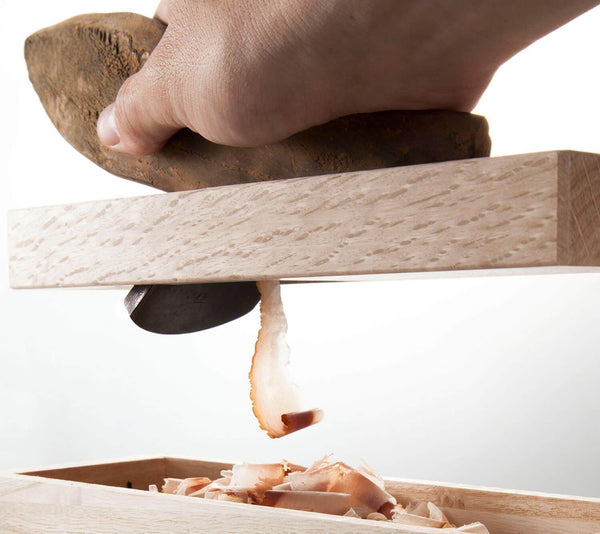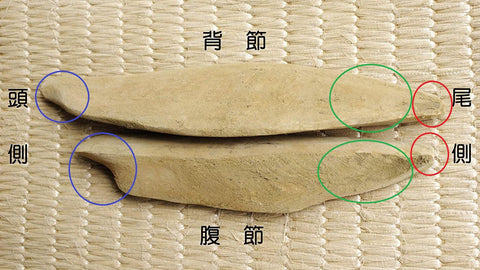
Jump to:
Introduction: Why is Homemade Katsuobushi So Special?
Katsuobushi, also known as dried bonito flakes, is an essential Japanese ingredient used to make dashi (a soup base for Japanese dishes) and enrich the flavor of dishes. In olden times, Japanese people made homemade katsuobushi by themselves at home: in fact, each Japanese household had a kezuriki (katsuobushi shaver) and they used to prepare katsuobushi on their own. However, few households continue this practice nowadays because it is time-consuming and ready-to-eat katsuobushi flakes are easily available at stores. This means that there has been a sharp decline in the practice of this Japanese tradition.
Nonetheless, why are some people, including those outside of Japan, willing to do this time- and effort-consuming preparation? Some may wish to perform katsuobushi shaving manually because they realize freshly-shaved katsuobushi has excellent flavor and umami that goes far beyond its conventionally prepared counterpart. On the other hand, there may be some people who have an interest in experiencing this Japanese tradition. Whatever their motivations, however, shaving katsuobushi is difficult for beginners.
Although methods of katsuobushi shaving vary between katsuobushi distributors and professional chefs of Japanese cuisine, the basic rules are quite similar, and once you learn these you can successfully create your own katsuobushi. In this article, we will show you how to make katsuobushi from a block of dried bonito flesh.

What You Need to Prepare and Know Before Shaving Katsuobushi
Even if you already have the dried bonito block and kezuriki shaver, you are unlikely to be able to successfully shave it without the correct knowledge. In this section, we would like to mention some important things you should know.
Necessary Equipment
To make original katsuobushi, you need a dried bonito block, kezuriki shaver, dry cloth, and wooden hammer. The dry cloth is necessary for wiping the bonito fillet or cleansing the plane of the kezuriki while the wooden hammer is an essential tool for adjusting the blade of the shaver. It is not recommended that you use a metal hammer as this exerts too much force on the shaver, which makes it difficult to finely adjust the blade.
Mold Removal
The Katsuobushi block has mold on its surface due to a long period of aging to enhance its flavor and expiry date. This mold is harmless to your body even when consumed and there is no problem in shaving the block with the mold still attached to it. However, removal of the mold allows you to shave the bonito block without getting your hands dirty and it also makes it easier to shave. If you are nervous about mold, wipe the surface of the katsuobushi with a dry cloth or disposable kitchen paper. Do not wet the block or this may cause deterioration of its flavor or umami.

Blade Adjustment
Basically, if you wish to create thick bonito flakes, you need to project the blade of the shaver from its surface and retract it for thinner flakes. However, you should bear in mind that projecting the blade from the shaver too much is not a good practice because this results in powdery katsuobushi and the blade is more likely to get nicked.
The ideal blade length is 0.1mm: a thickness equal to a sheet of newspaper. You can measure it roughly by gently touching the shaving part of the kezuriki with your finger. When you feel the edge of the blade (i.e. a metallic touch feel), you have successfully adjusted the blade to the correct length. However, when you perform this process, be sure to take care of your finger. Avoid touching the edge too strongly and do not move your finger parallel to the blade.
When adjusting the blade, use a hammer to hit the upper or lower part of the plane. The image below illustrates a typical wooden plane for a katsuobushi shaver seen from above. The black arrow shows the direction that the edge of the blade is facing; the red circled area is called the top end; and the blue circled area, the lower end. To project the blade, hold the plane with its blade pointing towards you and tap the lower end (blue circle) while if you wish to retract it, hold the plane with the edge facing the opposite way to you and tap the upper end (red circle). When the blade looks diagonally projected (i.e. not projected parallel to the wooden surface), adjust the blade by alternately tapping both ends of the lower/upper end instead of hitting the center only.

Checking the Parts of the Bonito Block
Shaving the wrong parts in the wrong direction will produce only powdered bonito, so you should correctly understand the parts of the bonito block. As shown in the image below, there are two types of katsuobushi: the upper one is the bonito’s back fillet, and the lower one is its belly, which is usually smaller than the back. The blue circles are referred to as the head side or simply the head; it is slightly concave in shape and there is usually a hollow curve on the tip. In contrast, the red circles refer to the tail side or tail; its tip is convex-shaped. The green-circled areas are bonito skin. It looks blackish in hue, rough in texture, and is always adjacent to the tail. This means that locating the skin makes it easy for you to find which side the tail is. Once you identify these parts, you can proceed to the shaving process.

How to Shave Katsuobushi and Create Beautiful Flakes
In this section, we will show you a step-by-step guide on how to shave katsuobushi. Check to the image below for reference purposes and to help you understand it more easily.
First of all, before shaving, place the kezuriki on a flat surface, if possible, this should be lower than your waist with its blade facing towards you (the red arrow in the image indicates the blade direction). Then, place your hand on the upper side of the block while pressing the head side down on the surface. Make sure that skin faces upward (the green arrow).
Next, adjust the angle: it is said that an angle of 40~45° to the blade allows you to create beautiful bonito flakes. With this method, the tail should be in the air while its tip faces against the blade like the blue circle in the image. Then, slide the katsuobushi back and forth across the blade as if you are rubbing the plane with the head side.

While shaving, there are two things that you should keep in mind. First, be patient: at the beginning of shaving, only powder will be generated. This is because the surface area of the unshaved head is small. If you keep shaving it, however, its surface becomes wider, and it will eventually generate flakes, so continue shaving the katsuobushi. You can use both of your hands to exert more force with better control.
The more you shave it, the smaller the block becomes, and this may make it difficult for you to shave the katsuobushi. In such a case, try the opposite motion: turn the shaver and block 180 degrees and pull the bonito block towards you. Be careful not to cut your fingers while doing this.
Major Troubles Occur in Katsuobushi Shaving and Their Solutions
This section describes some problems you may face while shaving the katsuobushi. The following information may be helpful to help you tackle these issues:
The shaver produces nothing but powder
In this case, you should check two things: the direction of the katsuobushi fillet and the blade. First, make sure that head, rather than the tail, faces the surface of the plain. If you shave katsuobushi from the tail side, you will hardly be able to produce any flakes. Secondly, the blade might be protruding from the plane too much. In such a case, adjust it by tapping the upper end of the plane.
Katsuobushi gets stuck on the blade
This may happen if the blade is protruding too much, so tap the upper end of the plane. Remember that the recommended blade length above the wooden surface is 0.1mm. If the edge is visible, expect that most of your shaved katsuobushi will be powder.

The orientation of the blade and katsuobushi are correct, but I cannot shave thin flakes
You may encounter this situation if the blade is heavily nicked. Although it depends on the type of shaver you use, you can resolve this problem by replacing or sharpening the blade. However, if there is no improvement even after trying these solutions, you may have to replace the kezuriki shaver itself.
Katsuobushi is too tough to shave
Katsuobushi hardens when it is stored in a cool place or if it loses moisture. In this case, heat the katsuobushi block by putting it closer to a flame (do not grill it directly). If your home does not have a gas flame burner, you can soften the katsuobushi by wiping its surface with a tightly squeezed cloth. When it is exposed to heat or wetness, it gets softer and this allows you to shave the flakes more easily. However, when you try these methods, it is highly recommended that you shave the whole block because these methods can later generate harmful molds from its cutting surface.
How to Store and Maintain Katsuobushi?
Katsuobushi is very vulnerable to humidity, which eventually creates harmful bacteria and significantly deteriorates their flavor and umami. To avoid this, store it in a well-ventilated place. In contrast to this, a refrigerator is unsuitable for katsuobushi because the coldness makes it tougher. However, it is acceptable to refrigerate bonito fillet during the rainy season. To prevent it from drying, however, wrap it with a plastic wrap or put it in a resealable bag.

For kezuriki shavers, especially those made of wood, wipe off remaining katsuobushi burrs with a dry and clean cloth. Do not wet-clean it or its wooden surface will get moldy. Regarding the blade, it is better not to wash with water unless it is made with stainless steel.
0 comments